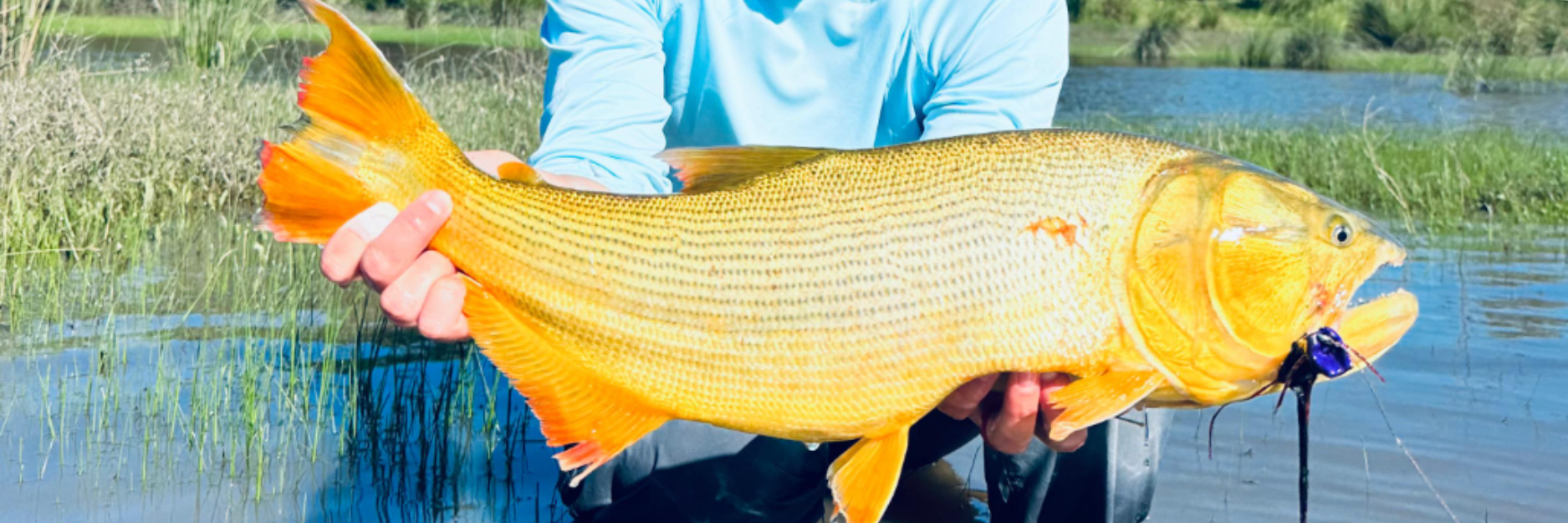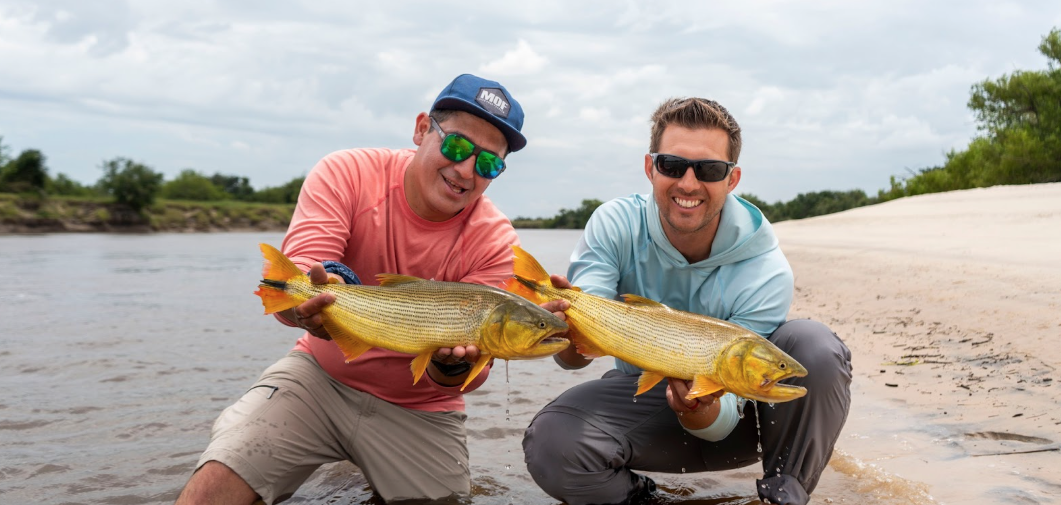[email protected] | 866-832-2987
Golden Dorado
The Golden Rocket of South America
Golden Dorado
The Golden Rocket of South America
Guide
The Dorado is one of South America’s most iconic and revered gamefish. Renowned for its dazzling golden scales, voracious feeding behavior, and acrobatic fights, this apex predator inhabits swift rivers of the Paraná, Paraguay, and Uruguay basins. Its name—Salminus—hints at a salmon-like lifestyle, and indeed, the dourado’s aggressive strikes, blistering runs, and leaping ability make it a favorite among freshwater anglers.
Adult dorado are powerful ambush predators, often found in fast, oxygen-rich waters where they hunt shoals of smaller fish like sabalo. Their powerful jaws are lined with sharp teeth capable of shredding baitfish—and poorly prepared tackle. Dourado are known for explosive surface attacks, which adds to their legendary status in South America’s sportfishing world.
Though they do not naturally inhabit the Amazon Basin, Acute Angling guests targeting golden dorado do so on specialized trips in the southern reaches of Argentina.
Interesting Facts & Notes
The species’ name, brasiliensis, reflects its importance in Brazil, where it is a cultural symbol.
Dorado are known for “migration runs” similar to salmon, following baitfish upstream to spawn.
They are prized table fare in local communities, but strict regulations often protect larger breeding fish.
Also known as the “tigre del río” or “river tiger” for their striped juveniles and ferocity.
Where to Catch Dorado
You can pursue this prized predator on Acute Angling’s southernmost offering:
Paraná River Golden Dorado Trip – Argentina-based fly-in trip targeting golden dorado in the Paraná River.
Dorado Quick Facts
| Attribute | Description |
|---|---|
| Scientific Name | Salminus brasiliensis |
| Common Names | Dorado, River Tiger, Golden Dorado |
| Size Range | 5–18 lbs common; can reach 40+ lbs |
| Region | Southern South America: Argentina, Brazil, Paraguay |
| Habitat | Fast, clear rivers with rocky bottoms |
| Behavior | Migratory ambush predator |
| Coloration | Bright gold with metallic green and black highlights |
| Aggression | Very high – explosive and territorial |
| Feeding Habits | Carnivorous – primarily fish (especially sabalo) |
| Gamefish Status | Elite – fast runs, jumps, and surface strikes |
Physical Appearance
The dorado is unmistakable. Its body is streamlined and muscular, built for speed and sudden bursts of energy. The golden scales shimmer with iridescent green and bronze hues, and the fish’s large mouth and slightly upturned jaw give it a fierce, predatory look. Juveniles exhibit faint vertical bars, earning the nickname “river tiger.”

How to Identify a Dorado
Brilliant gold coloration with darker green back and silver underside.
Large mouth with sharp teeth and strong lower jaw.
Fusiform body (torpedo-shaped) built for high-speed bursts.
Juveniles often display tiger-like vertical striping.
Large, deeply forked tail adapted for fighting strong current.
How to Catch Dorado
Dorado are some of the most exciting fish to catch in freshwater. They demand strong tackle, quick reflexes, and precise casting.
Recommended Techniques
Use large streamers or baitfish-imitating lures in fast-moving water.
Fish structure like current seams, rock piles, and eddies.
Fly fishers should cast across current and strip aggressively.
Suggested Gear
Rod: Medium-heavy baitcasting/spinning; 8–9 wt fly rod
Line: 40–60 lb braid or heavy fly line
Leader: Wire tippet essential due to sharp teeth
Hooks: Strong 2/0–5/0 for lures or flies

Join the Adventure
Hook into South America’s golden rocket—travel with Acute Angling to pursue one of the world’s fiercest freshwater predators.
Contact us today:
📞 (866) 832-2987
Golden Dorado in Action
Related Reading
References
Oyakawa, O.T. & Mattox, G.M.T. (2009). Revision of Hoplias.
Vazzoler, A.E.A. (1996). Biologia da reprodução de peixes teleósteos.
Agostinho, A.A. et al. (2004). Estrutura trófica e conservação.
Ferreira, E.J.G., Zuanon, J. & Santos, G.M. (2007). Peixes comerciais do médio Amazonas.
Marcenik, V. & Hilsdorf, A.W.S. (2010). Genetic conservation of Neotropical fishes.
Zeinad, A. K. & Prado, R. A. (2012). Peixes fluviais do Brasil: espécies esportivas
